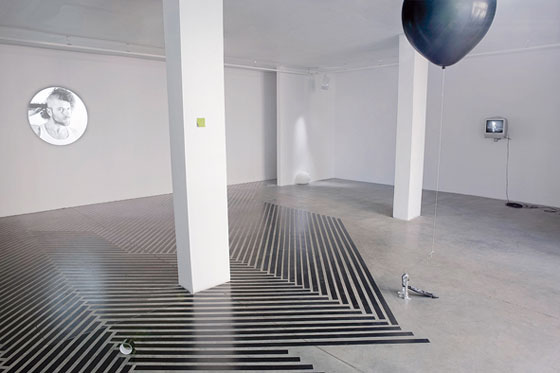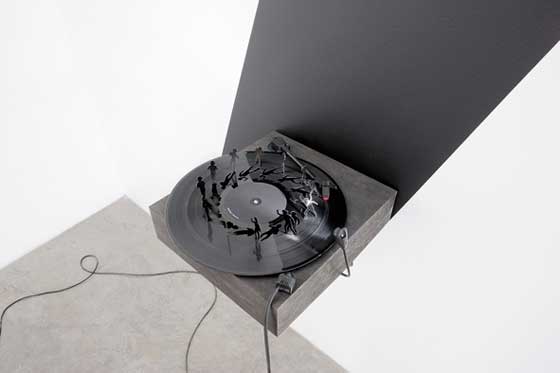|
|
| Sleepless rogues Jānis Borgs, Art Critic Krišs Salmanis. Insomnia 04.09.–03.10.2010. kim?. Gallery VKN | |
| In Latvia also, the streams of postmodernism have polished up “nuggets and diamonds” of talent of our own. Such descriptions intended as compliments would perhaps be more appropriate to bourgeois (or even criminal) passions and values, and less so to artists in vanguard positions. Hence, if this did not sound like common name-calling, he too, Krišs Salmanis, could be deemed a rogue. A “polished rogue”, schooled in the land of Joseph Beuys himself, a rogue not in the shady meaning of the word, but in its tastiest sense – like a ripe, shiny, juicy and crunchy apple on a counter in the Central Market. A similarly healthy contribution of the autumn harvest was once again “put on the table” not far from the said market, in the exceptionally active centre of contemporary art kim?, i.e. Gallery VKN, in the form of an exhibition of artifacts by Krišs Salmanis titled Bezmiegs (‘Insomnia’). And sleep does indeed disappear for some time, as the impressions of what we have seen bubble up every once in a while in the dense mass of our consciousness, like gas in an opened bottle of sparkling mineral water. | |
 Krišs Salmanis. Exhibition 'Insomnia' at the VKN gallery. Composite view. 2010. Photo: Krišs Salmanis | |
| In the small exhibition room, we saw a rather ascetic array of art objects, as is now quite usual. Once again, a thought (not addressed to Salmanis) crossed my mind – is anybody ever going to piece together something other than the established flirt with the beauty of emptiness? However, executed by Krišs Salmanis, this has turned out to be so well-balanced and so professionally tasteful as to raise suspicion that the cosmetic aestheticism of our rogue may disguise a modernist gentleman, who is up to some fun and games in the “street of broken lanterns” populated by “hooligans” of the avant-garde. Anyhow, a detective investigator in art processes could find here traces of a good education, as well as prints left by fingers trained in the commercial culture of advertising. In this case it had true charm and brought intellectual enjoyment. Like when launching into Kafka’s works. While watching a desperate struggle with the artist’s body hair in the animation loop titled Sarežģītais veltīgums (‘Complicated Futility’), the workings of one’s mind are bogged down in the quagmire of nocturnal nightmare. Although there is nothing particularly complicated there, what we see correlates well with many ‘real life’ Laocoonian situations. For instance, a grand and monumental bridge built in the late 19th century near Edinburgh, Scotland, which has been painted non-stop for 120 years: by the time they reach one end, the other is already getting rusty… A similar nightmare goes around and round, in Hitchcockian manner, in the zootrope-like video installation Insomnia, where anonymous little people run a relentless marathon in a neverending circle. Here too, the “futility” of the process leads towards an existential contemplation on the “meaning of life”. And only the video-mediated image imbues it with a certain social angle of vision, and emotional uplift. However, the eternal questions – Who? Where to? Why? – remain open, and every now and then ring in one’s consciousness like wind chimes in a Zen Buddhist garden of stones. The only wan lettuce-green touch of colour in the black and white composition somewhat marginally but consistently flashes in a number-haiku: 7, 6 / 5, 4, 3, 2 / 1, 10, scribbled on a small paper sticker. An element that could easily have failed stands out here with its conceptual finesse and intellectuality. As is the case with the exhibiton as a whole. Not far off there is a black square on white, immediately eliciting an almost queasy association with Malevich: yuk, what banality! But nothing of the kind: this is again an intellectual and ironic challenge to yet another great master of European culture, film director Michelangelo Antonioni, setting his famous movie Blowup in counterpoint to Salmanis’ Blowdown which is a photogram of the famous cinematic piece in a 110 minute exposition. | |
 Krišs Salmanis. Insomnia (A version of zootrope). Laser-cut and bent record, record player, lamp, surveillance camera, monitor. 2010. Photo: Krišs Salmanis | |
| And then there’s more – two installations of helium filled rubber balloons. The white balloon, “poor thing”, has been squashed under the weight of a wall, no less white, but the black bladder, proudly erect and pushing towards the ceiling, is held in check on a string in the very middle of the room. The viewer is invited to perform an act of communication with the balloon by treading on a small pedal. Like pulling a cat by its tail… The comic profundity of meaning behind the objects takes on quite a serious turn if we look at them from the positions of aestheticism, as elements vital for compositional balance in the exposition. This ever-present ambivalence, too, can be added as a special plus to the artistic achievements of Krišs Salmanis. The notion of aestheticism has been brought to its highest point in Lūzera parkets (‘Loser’s parquet’) – a minimalist graphic pattern of parallel stripes laid out on the floor with black adhesive tape. The exhibition’s visual structure, alongside its philosophic content and ironic wit, reveals a definite pattern of geometrical forms, or an order, built by clearly defined black-and-white accents in layered arrangements of circles, squares and lines. Moreover, these are successfully synthesized with the architectonic whole of the exhibition room. And this is now a completely unexpected synergy, testifying to outstanding expertise and competence. It outgrows the level expected of a rank-and-file artist and raises this exhibition to being a truly multidimensional masterpiece. Krišs Salmanis has reached Jesus’ age, an age when he should say good-bye to the status of ‘young artist’. In the words of a Latvian poet: “... a rabbit who runs into a forest, it’s a rabbit no more. It is a hare for sure.” But the forest of our art now resounds with the roar of a genuine and new tiger from the big world. May he always have “insomnia”. /Translator into English: Sarmīte Lietuviete/ | |
| go back | |







